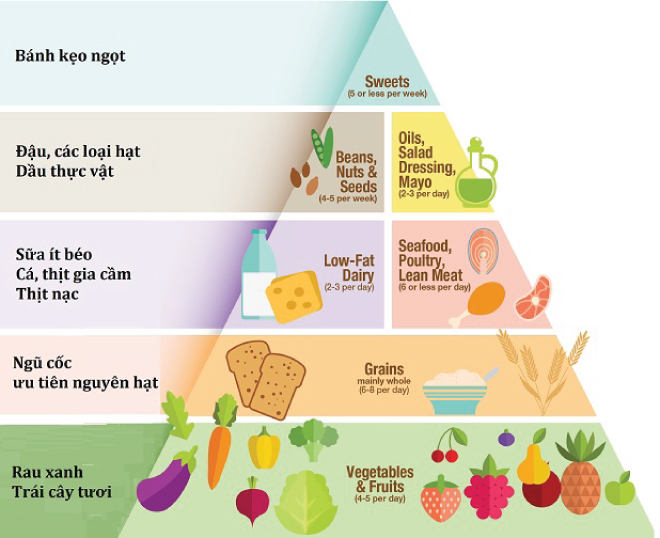Nutritional principles also play an important role in diabetes treatment with the aim of ensuring a balanced supply of both quantity and quality of nutritional ingredients to regulate blood sugar and achieve treatment goals well.
1. Principle 1: Diverse diet
A diverse, complete diet from many food sources will provide enough nutrients to help the body function normally. Diabetic patients, especially children, need a diet full of nutrients to ensure the child's normal physical and intellectual development.
Normally, a balanced diet must contain all groups of substances: carbohydrates, protein, fat, fiber and minerals to ensure the patient's health:
- Protein (Protid): Accounts for 15-20% of dietary energy (equivalent to 0.8g/kg/day for adults), helping cells and tissues of organs and parts of the body develop. However, patients with kidney disease should pay attention to adjusting the amount of protein the body receives.
- Fat (Lipid): The proportion of energy due to fat should be 25% of total dietary energy, and should not exceed 30% in the diet. Limit saturated fat (animal fat) because it easily causes atherosclerosis. Instead, you should eat unsaturated fats found in vegetable oils such as sesame oil, soybean oil, sunflower oil... to provide energy for the body and help absorb some vitamins.
- Carbohydrates (Glucid): The proportion of energy provided by glucid should reach 50-60% of the total dietary energy. You should use complex carbohydrates in the form of seeds, potatoes,... and limit simple sugars and foods with high sugar content (cakes, candy, soft drinks...).

Ratio of nutrient groups for people with diabetes
The amount of food must depend on the patient's weight and physical activity level.
2. Principle 2: Maintain 3 main meals
You should maintain a stable 3 main meals in your daily diet. For people with stable weight and well-controlled blood sugar, there is no need to eat extra meals or split meals.
Patients who only eat extra meals when exercising a lot are at risk of hypoglycemia, which is dangerous, such as elderly patients, severe cardiovascular complications, kidney failure, or patients taking insulin, need to be considered. Consider having a snack.
Eating 3 meals a day, along with light meals, will help avoid the above risks and stabilize blood glucose levels.
3. Principle 3: Increase fiber
Fiber is very good in the treatment of diabetics because it has the ability to control sugar and fat levels and control blood pressure.
Foods high in fiber such as green vegetables and some fruits will stay in the stomach longer, preventing digestive enzymes from acting on food, slowing down the digestive process and limiting the absorption of sugar into the blood.
The standard amount of fiber for an adult is recommended to be between 20-50g per day.
4. Principle 4: Use healthy cooking methods
The simpler the cooking method, the better it retains the nutritional content of the food. Therefore, healthy cooking methods often do not require many processing steps, limit spices, and prioritize natural spices. Specifically, we need to note the following points:
- Use cooking methods that limit fat such as boiling, steaming, stewing, etc. instead of pan-frying or deep-frying.
- Use natural spices and less sugar.
- Avoid using foods high in carbohydrates (cornstarch, wheat flour,...) to prepare dishes.
Nutritional guidelines for diabetes are established to shape nutritional regimens, as well as remind patients about how to care for and improve their health. In addition to complying with nutritional principles, diabetics need to follow the diabetes treatment regimen to better stabilize blood sugar, increase the effectiveness of the treatment process and limit future complications.
See product information here
